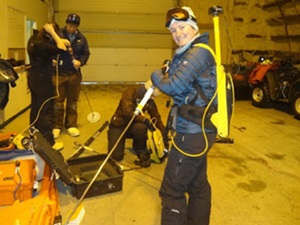
The Arctic is a hub for climate change research, and Dr Gina Henderson, who is originally from Dalkey in Co Dublin, is looking at how snow and ice cover there could be affected by weather patterns as far away as the tropics. Claire O’Connell caught up with the intrepid researcher.
We may have had bitterly cold wind and snow in Ireland this week, but the unseasonal cold snap is nothing compared to conditions in the Arctic. Henderson has just returned from Barrow in northern Alaska, where temperatures plummeted to -30°C as a team built equipment to collect climate data from the polar region. Henderson, who works with the United States Naval Academy, was well wrapped up against the cold, but there were still practical challenges.
“I wasn’t expecting to be as comfortable as I was once in the field,” she says. “But the hardest thing is the wind, if the wind is up it brings a whole new meaning to the word wind chill. And a lot of the time we are working with instruments that require a bit of dexterity, so you have to take off your outer glove, and if you do that even for a minute it’s really hard to warm up afterwards.”
From Dalkey to the world
So how does a Dalkey native find herself out in the Arctic negotiating chilly glove-related situations?
It all started in University College Dublin, where Henderson completed an undergraduate degree in geography, and her dissertation looked at the climatology of storm tracks, or paths, across the North Atlantic. A keen sailor, Henderson was drawn to the field. “I grew up sailing and racing in Dun Laoghaire harbour, that is the big tie in,” she says.
The next academic port of call was the University of Delaware, where she developed an interest in the relationship between large-scale snow cover and its effects on storm tracks and longer-term winter weather. Her PhD work looked at coupling climate models of the upper layers of the ocean to an atmosphere model, to better predict the impacts of snow.
During a brief spell researching in Rutgers University, she got the opportunity to move to the USNA in Maryland, and again sailing forged the connection. “I had a conversation on a dock after a sailing race in Maryland. I got introduced to someone from USNA, and that eventually resulted in me being offered a position there,” says Henderson, who now teaches oceanography and climatology to classes of ‘midshipmen’. “If you asked me would I end up working at a military academy … it’s not something that is on the radar of the average Irish person, but half of the faculty are civilian here.”
Changing tack to research
While teaching is the main focus in term time, Henderson changes tack in the summer and dedicates months to her climate research, and her sights are set on the Arctic.
“The Arctic is pretty much a hive of activity for climate research right now,” she explains. “It serves as a barometer for climate change, things are changing so rapidly up there. And the Navy is very operationally concerned and interested in how things are changing in the Arctic: as that ocean opens up it’s going to be an environment that the future Navy officers are going to be operating in. They want climate-literate officers, and any sort of predictability or better forecasting skills for the Arctic is big on the research agenda.”
One of Henderson’s lines of work looks at potential links between two climate-related phenomena in different parts of the globe. She and a colleague at USNA are examining the relationship between sea-ice concentration and snow cover in the polar region and the Madden-Julian oscillation, a tropical atmospheric pattern related to rainfall.
Funded by the National Science Foundation, the work analyses datasets and involves “a lot of number crunching,” as Henderson describes. So she jumped at the opportunity this spring to head north for a field trip to the north slope of Alaska with a group of students to build instruments that can detect climate data. “I have been using Arctic data for so long, it was fantastic to get the chance to go and collect it,” she says.
The instruments they deployed include a hydrophone, a microphone that can work in water, which they placed in sea under ice. “We are trying to detect sounds of the ice starting to open up and cracking, and with the acoustic measurement we can hopefully monitor that in a different way, from underneath,” she says. “And we deployed it on a piece of ice that is going to break off and flow, so we can get not only the sound of the ice breaking but also the rate [at which it is moving].”
Big world to research
Henderson’s research analyses large chunks of the world, and her advice to students with an interest in science, engineering and research is to be enthusiastic and think big about their futures. “Don’t be scared to look far afield,” she says. “There are networks of Irish professionals everywhere.” And, particularly as a woman, she has found support and encouragement from groups in the United States: “I have come across numerous organisations and mentor opportunities that have helped along the way.”
Source: Silicon Republic – Climatologist’s Journey from Dalkey to the Arctic – Via the US Navy





